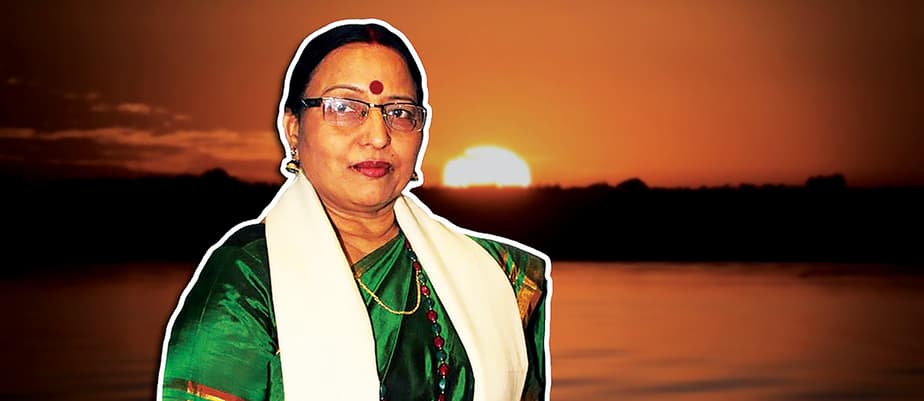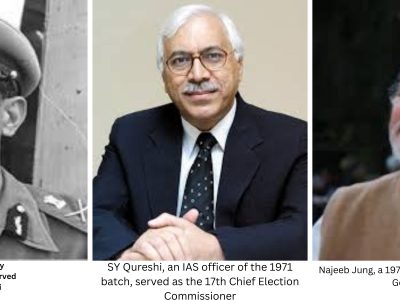If Chhath is the most visible unifier in Bihar, Sharda Sinha is its voice
In November 2016, the white collar non-resident Bihari had his Chhath moment in a Sharda Sinha number, one of the only two festive songs she has sung this decade. The viral video of the song shows an English-speaking Bihari’s wife finding a way to perform Chhath puja in what seems a foreign land. It could be any of India’s metro cities too.
Eventually, the class wouldn’t matter even if the migrant blue-collar Bihari workers brave being confined to the toilets of overcrowded trains while going home for the festival. They will all sing the same songs, and Chhath ghats and water bodies will resonate with the same numbers. If Chhath is the most visible unifier in Bihar, Sharda Sinha is definitely its voice. Even official public address systems used by the state government on Chhath ghats can’t miss Sharda Sinha numbers, as evident in Patna district administration’s plan for ghats in 2018.
Her new song, for instance, brings out the interesting blend of commitment and an anxious sense of inadequacy which accompanies the new generation of devotees, as the festival is known for observing high standards of cleanliness, ritual discipline and rigour. It asks for forgiveness in the event of mistakes, as the song begins with these lines: “Pahile pahil hum kaini Chhathi maiya barat tohar/Karihai kshama chhath maiya, bhool chuk galti hamaar“(For the first time Mother Chhathi, I have observed fast in your name, please forgive my mistakes and failures).
Such awestruck caution also easily gives way to affectionate banter with the Sun God—both the rising and the setting sun—to whom the festival is dedicated. This sense of entitlement on the Sun God’s benevolence underpins these lines from a popular song, as the devotees complain about the late sunrise: “Aaun din ugaee chha ho Dinanath aahe bhor bhinsaar/Aaj ke dinwa ho Dinanath he laagal yeti ber” (O Sun, on any other day you rise very early in the morning, but you are getting late today).
When the sun finally appears, Sharda gives voice to the joy of the sun’s radiance spread across banana leaves and guava leaves. The pleasure of sighting is expressed: “Kelwa ke paat par ugel han Surujmal” (Sun has risen on the banana leaves).
If Chhath is the most visible unifier in Bihar, Sharda Sinha is its voice.
In November 2016, the white collar non-resident Bihari had his Chhath moment in a Sharda Sinha number, one of the only two festive songs she has sung this decade. The viral video of the song shows an English-speaking Bihari’s wife finding a way to perform Chhath puja in what seems a foreign land. It could be any of India’s metro cities too.
Eventually, the class wouldn’t matter even if the migrant blue-collar Bihari workers brave being confined to the toilets of overcrowded trains while going home for the festival. They will all sing the same songs, and Chhath ghats and water bodies will resonate with the same numbers. If Chhath is the most visible unifier in Bihar, Sharda Sinha is definitely its voice. Even official public address systems used by the state government on Chhath ghats can’t miss Sharda Sinha numbers, as evident in Patna district administration’s plan for ghats in 2018.
Her new song, for instance, brings out the interesting blend of commitment and an anxious sense of inadequacy which accompanies the new generation of devotees, as the festival is known for observing high standards of cleanliness, ritual discipline and rigour. It asks for forgiveness in the event of mistakes, as the song begins with these lines: Pahile pahil hum kaini Chhathi maiya barat tohar/Karihai kshama chhath maiya, bhool chuk galti hamaar (“For the first time Mother Chhathi, I have observed fast in your name, please forgive my mistakes and failures”).
In recent years, the swelling crowds, distance and urban negotiations with convenience have seen people using small water bodies and storing systems on the terrace as new offering sites. However, the ghats are still the big draw. The state capital’s ghats figure among the most coveted for sun-worship.
In making it possible, Ganga has been rather considerate. Lore has it that Gautam Buddha, the most famous Patna-watcher, had cautioned the ancient city against the dangers of flood, fire and feud. To its credit, the city has heeded his advice. It has not witnessed any major fire for a long, long time, has survived dissensions to be an important player in democratic statecraft, and the majestic Ganga has not inundated the city since 1975. Sharda expresses the popular yearning for performing Chhath on Patna’s ghats. The song says it all, simply: “Patna ke ghat pe hum hu aragiya debayee he chhathi maiyya, hum na jayaem dussar ghat, he chhathhi maiyya” (O Mother Chhath I shall also make an offering on the ghats of Patna, I shall not go to any other ghat, O Mother Chhath).
There are many ways in which Chhath derives its unique appeal in Bihar and districts bordering the state in Uttar Pradesh and Jharkhand. One, obviously, is its worship of the rising as well as the setting sun—something which even Prime Minister Narendra Modi couldn’t forget mentioning to his audience a few years ago.
Apart from this pristine form of nature veneration, the most striking feature of Chhath is how each devotee gets the cohesive assistance of a collectivity—family, neighbours and even the unknown—to successfully perform meticulous rituals. Carrying the offerings to the ghat or water bodies is one of them. Sharda encourages and blesses a young boy to do that for her in this number: “Tu hi babu daurwa le jayeha, aragh dilayea, nirmal hoyea, pari pari suruj ke payea ho (You carry the bamboo basket, you help in making the offerings to Sun and be clean by prostrating before the Sun).
And then there is this gaam ke adhikari song expressing the same with more specific expectations.
Sharda has been the vocal personification of Chhath in all the dialects of Bihar: Bhojpuri, Magahi, Bajjika and Angika, as well in Maithili, which has now the status of a constitutionally recognised language. She had her share of beautifully rendered Bollywood numbers as she intermittently gave her distinct voice to popular songs like “Kahe Tose Sajna Maine Pyar Kiya,” 1989) and “Taar bijli se (Gangs of Wasseypur – 2, 2012). However, her appeal is firmly rooted in a large number of folk and Chhath songs she has sung with irreplaceable sublimity in last four decades. The Padma Bhushan recognition for her in January 2018 came too late. By then, her legacy had long been firmly established in popular imagination, her voice immortalised in the lyrical idea of Chhath.
In her decade of withdrawal from the Chhath musical scene, new singers emerged with their own versions of iconic songs or offered new ones with varying degrees of freshness. One of the popular songs beyond Sharda’s fold is Marwo re sugwa dhanush se.
However, Sharda’s songs remained the default numbers for homes as well as sound systems on ghats. There was something inexplicable that couldn’t be found in anyone else’s Chhath renderings. In many ways, her voice had become a kind of ritual itself.
Year 2018 has witnessed some musical attempts, common during Holi, to capture the Chhath homecoming of migrant workers from the state. They have hardly done any justice to either their joy or journey ordeals or even their failure to make it back home. In times when the musical discovery of Chhath is a prelude to its cultural capital, Bihar’s festive autumn has a constant. Sharda Sinha is so much Bihar’s autumn habit.
www.newslaundry.com





